#but from what i gathered the main difference with ratio is that ratio is so ambitious his goals cover innumerable galaxies
Explore tagged Tumblr posts
Text
been going through the sumeru archon quest finally (met alhaitham)(my camera roll is just a hundred screenshots of his face)(I'm perfectly normal about him wym) and i think i get why people say comparing him to ratio isn't exactly correct but talking to him does feel like talking to ratio in a surprisingly uncanny way I can't even lie about that
#most of what i know about haitham atp is what i already knew before playing let's start with that#but from what i gathered the main difference with ratio is that ratio is so ambitious his goals cover innumerable galaxies#while haitham really onlt wants to be left alone to chill in peace#given that at least for ratio that's p much the core of his character I'd say it's normal to think they aren't all that similar#but the things they say......the way they interact with people.......the tone they use when talking even...........#if you ignore their life goals i feel like#at least for how much i know haitham now that is#the main difference between them is that maybe ratio is more caring than haitham#but maybe haitham is nicer than ratio#? does that make sense#haithams way of helping is nicer#but he doesn't care to help as much as ratio does#at the same time ratio is harsher with his words and actions than haitham is#but every single one of his actions is meant to care#haitham will sit and look at you and wait for you to find your own answers#which is Extremely ratio of him they both give super strong professor vibes#at more than one point he was like why are you asking when you know the answer#this is something ratio has said way more than once too#but maybe I feel like ratio asks to teach you how to think#and haitham asks because he'd prefer it if you didn't bother him#at the same time tho haitham will more easily hold your metaphorical hand when reaching a conclusion#while ratio will actively antagonize you just to make sure you're truly sure of what you're saying#it's the feeling they've been giving me#how do i say this#it's less their words and attitudes that are different since they match nearly perfectly#and more the intentions behind their words and attitudes#?#then again#I'm still investigating the hospital so this is just my initial understanding of haitham#maybe i got him completely wrong
2 notes
·
View notes
Text
POLL RESULTS JUST DROPPED!!
My hockeyblr experiences are largely catered to my own personal tastes -- mostly Leafs, a little Penguins and Stars, one or two who post about Stevie Y and Sergei Fedorov. These are obviously not the only teams out there.
This study was designed to survey as much of hockeyblr as it possibly could, gathering data on which teams people like and to what degrees. There were five questions and a free space -- my attempt to ask people to rank the teams they enjoyed in three levels, from religiously followed to casually affectionate, and an additional couple of questions on love for players versus team. I received over 500 responses. Here are the results.
Yeah, yeah, you all want to know: The most popular team is the Penguins, by a long shot, then the Leafs.
Because my sample size (n = 523) is actually fairly small compared to the number of NHL teams there are, I find definitive rankings tend to be difficult. It’s also worth noting that, as a mainly Leafs blog, my numbers are definitely going to be skewed a little in favour of the Leafs.
Your Guys
These are the teams closest to your heart: the ship you go down with, metaphorically or, depending on how married your old men are, literally. For me, I picked just the Leafs.
The average respondent had 1.9 teams in this category. The most popular, by far, was the Pittsburgh Penguins. Below is a table of teams, arranged roughly into tiers by the number of respondents. Each team has the number of respondents in brackets next to their three-letter code.
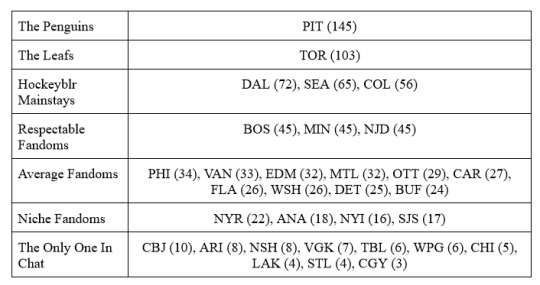
I allowed people to pick as many teams as they would like; the average person picked 1.9 teams, but here’s a distribution of how many teams they picked:
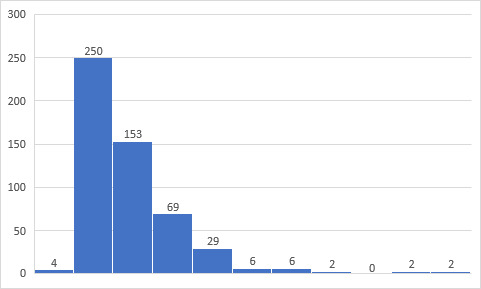
4 people picked 0 “your guys” teams, and 2 people picked seven, nine, or ten each teams. Just about half of people had one main team.
I then wondered: what teams were people most likely to only follow? That is, if you hold [x] team in the closest part of your heart, are you more or less likely to also hold any other teams? Almost exactly 25% of picks were solo; I wondered if there was any correlation at all.

Only a little bit! Of the samples large enough to actually consider (so: nothing in that cluster at the bottom left, who all received fewer than 10 picks total, and a few of whom -- CGY, CHI, NSH -- received zero solo pickers), the most devoted fans chose the Sharks, the Bruins, and the Leafs. The fans who liked the most other teams chose the Avs, the Kraken, the Canucks, Panthers, Sens, and Ducks.
Probably a next step would be to look for correlations: if people are a fan of one team, are they more likely to be fans of another? THAT BEING SAID that’s a lot of regressions. Maybe keep an eye on that for the future, but I don’t know!!
Objects of Enjoyment, and Generally Nice
These two were successive tiers meant to distinguish teams that people like from the ones in the category above. I admit I probably could have phrased the questions better; I received several comments saying that they’d watch any hockey when they wanted to put a game on. The dynamics between Your Guys versus Objects of Enjoyment versus Generally Nice would best be described as devoted fan of versus casual fan of versus favourable opinion towards.
As I said a few paragraphs back, people picked 1.9 “devoted fan” teams on average. Again on average, they picked 4.7 “casual fan” teams and 6.5 “favourable opinion” teams. Not all ratios are equal, though! Some teams had significantly more casual than devoted fans, and others still were much more liked generally than average.
I gave each team’s “devoted” count an index number of 1 and measured their casual and favourable count as a ratio against the index number. The teams assembled themselves into a few groups.
No Commitment

Arizona and Anaheim have decided to be soulbonded (Excel refuses to let them have different-coloured dots) and it took me three hundred million years to attempt to (and unsuccessfully) fix, so let’s ignore that. These teams all have a fairly high slope of interest -- a range of casual interest at about five times the pace of fervent interest, and good opinion at about ten times fervent interest. The Calgary Flames are an outlier on the entire graph, not just here.
Casual Interest
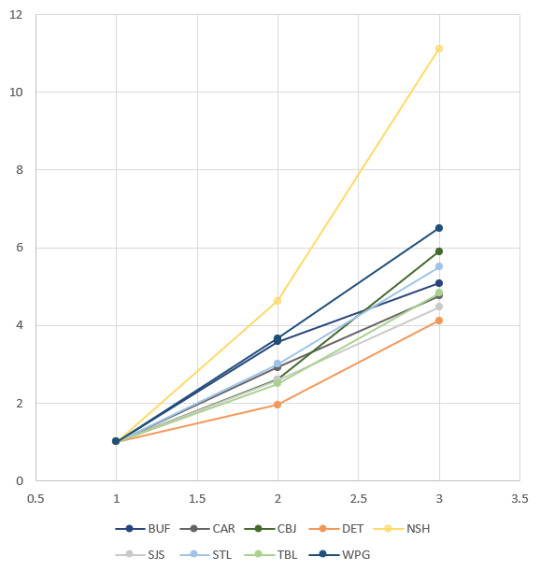
I gave up on trying to colour teams according to their real colours shortly after the Anaheim/Arizona debacle. Please employ the legend. Nashville is included on all five graphs for reference. These teams all have a casual interest factor of about 3, and a favourable opinion factor of around 5; the same ratio as the casual fans of the teams in the first category to their fervent fans.
Saturated Market

These teams have a much lower ratio of hardcore:casual:favourable fans, at about 1:2:3.
We Get It, Those Are Your Guys

Pittsburgh and Toronto; these teams have an almost equal ratio of all three categories.
...Whatever This Is
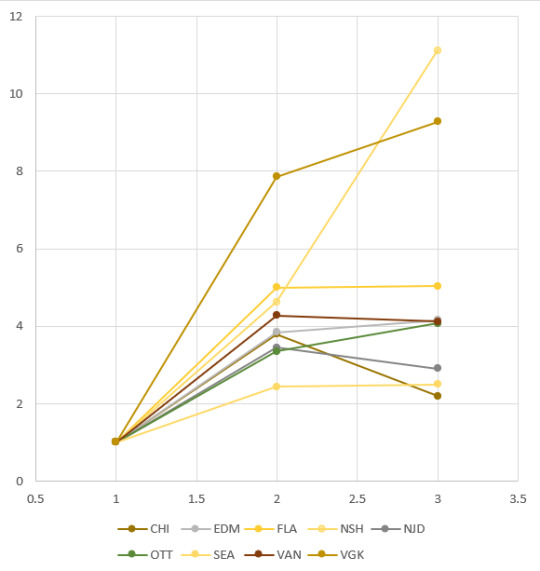
Every other category is defined by its ratios; this category is defined by its shape. While all teams have their rate of hardcore fandom set as 1, the other two tend to increase in a roughly linear form, without too much significant difference between the first interval and the second interval.
These teams, though (again, Nashville is for scale) don’t do that: they have a set increase between hardcore and casual, and a significantly smaller increase (or, in a couple cases, a decrease) between casual and favourable. This suggests perhaps some kind of divisiveness; if you’re not already in there, do you really want to get in further? Either that, or it’s something closer to what the Leafs and Penguins have: that is, a devotion. Like you’re in or you’re out.
Taking these values together
Because the casual:hardcore ratios are measured as indexes and not absolute values, they say nothing about the actual popularity of the team in question -- Calgary is one of the least popular, which is why I assume it’s so weirdly high up; small sample sizes lead to higher error values!
But we do have the absolute values, so we can measure them against each other.
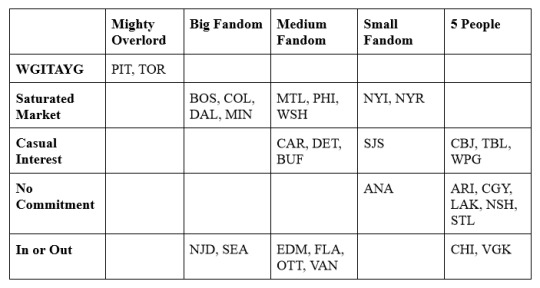
If we consider the “In or Out” to be a category of its own while the other four are along more of a continuum, then we can absolutely see a correlation here -- larger fandoms tend to have more involved fanbases.
Players or Teams?
I also asked participants if their guys tended to be players or teams -- and if those they liked at a more casual level tended to be players or teams.
The results are… not particularly surprising.

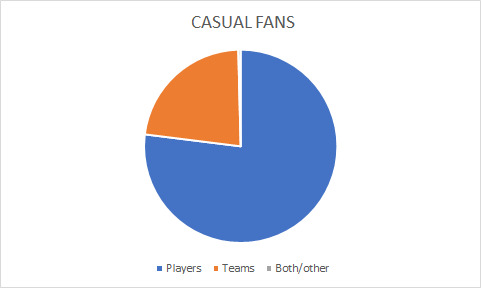
On a hardcore level, people tended to prefer teams, although the variability was pretty slight. On a casual level, individual players were much more popular.
I also wondered if people who chose more teams in the hardcore fan question tended to do that because they prefer players.
On average, people who picked players on their hardcore level chose 2.1 teams. People who picked teams chose 1.7 teams. That’s definitely a difference!
Fun Shtuff
I got way more write-in responses on the hardcore player/team question than on the casual question, including this:

Three separate people answered “Minnesota Wild” for their guys and chose no other teams on any level. Hell yes. (One person also did this for the Kings.)
It took about 300 responses before the first Flames fan (at the hardcore level.)
On all three levels, the Seattle Kraken are really popular -- they’re in the top five in each.
What's Next?
If I were to update this survey, I would probably include a question about where all of you are from -- some people (like me) follow their hometown team, while some people most certainly don't (shoutout to the one person from Edmonton who dislikes the Oilers) and others still don't have a hometown team (shoutout to my brasilian + european + etc mutuals and everyone else!!)
Feel free to shoot me an ask if you want me to do anything else with this data -- examine a specific team, give actual casual fan/etc counts and total aggregate rankings, anything else!
205 notes
·
View notes
Text
hello everyone and welcome to yet another sillyworld lore dump, here's part 1
in sillyworld mermaid kisses were once a sought after cure for scurvy, but that was a misunderstanding from sailors being fed citrus fruits by kind flocks of sirens, who actually don't sink ships on purpose but rather try to guide sailors to shore, unfortunately sailors can't hear directions well in high winds
the sailors would spread this rumor btw, saying mermaids were kissing them to heal ailments
there's candy brand called Mermaid Kisses also, with a slogan like "a sweet treat for yourself and me" or something silly like that
bogs and swamps and other murky bodies of water are more likely to have froglike water spirits due to their nature
Swamp, the skull gang member, as mentioned on the blog, was found in such an area
however, this isn't to say they're a nature spirit, but they could have known one
also there's a big difference between mermaids and sirens I think, but many will get them mixed up, like rabbits and hares or bunnies
the main difference would be dietary variations, for example; mermaids will mainly eat underwater plantlife and occasionally plankton, and will usually grow rather large in size, similar to filter feeding whales, but with the addition of having arms and hands to pick plants or in some cases farm them
many pods of mermaids have watched over the oceans plantlife for centuries
sirens on the other hand usually are carnivorous, being relatively small compared to mermaids, and much more humanoid, though some variations have been observed to be almost horse like, which is where the folklore for kelpies came about
ocean sirens will usually only travel in pods if they're hunting, but some have been observed traveling in a sort of patrol pattern near cargo and passenger ships, almost as if watching and protecting
Swamp is a murky siren, which gives them their froglike qualities, and their voice has more of a croaky tone
usually an ocean sirens voice will be sorta husky with a rasp to it from the salt
freshwater sirens will rarely sing or speak, preferring a dolphinlike whistle and click method
"beastmen" or animal abilitied people usually can be attracted by "beast summoners" no matter how low their animal ratio is, this is due to beast summoners abilities being caused by a scent pheromone that attracts whatever their specialty is
full summoners are usually designated to animal care duties due to their pheromone making the animals docile to them
the pheromone will cause a sedative effect and make the creatures more easy to control
beast summoners aren't allowed to use their ability freely without taking emotional regulation courses and attending regular therapy visits
beastmen also maybe have to have specific healthcare requirements also, due to being part animal, so all doctors and healthcare workers technically double as vets, and as such they require a lot of specialty training also
summoners will sometimes work alongside doctors dealing with beastmen, making sure everything can be as safe as possible during emergency or tedious procedures
there are types of spirits in sillyworld that are the accumulated energy of an area with some kind of conduit, usually a body of water or a prized possession
some spirits can be created from certain beliefs
there's also pest spirits called "guardian angels" that manifest in desperate times, but they're akin to raccoons in that they cause lots of mischief and sometimes get rabid
that's why there's also specialists in pest control that deal with those certain types of situations, which is basically what Matty and Sam do in Paranormal Encounters, my other story that takes place in the same universe
stars and star symbols hold a lot of power in sillyworld, because it's believed that every creature has star essence in some capacity, and that if a creature gathers enough then it could ascend to godhood in a sense, this quest of course has unfortunate consequences
many rulers and people in positions of power have tried to harvest star energy to become immortal or "ascend to godhood"
the "true" way to ascend, in the way they would want, would actually be to become a lost soul and conglomerate with other lost souls, until the consciousness start losing themselves, or what remains, becoming a sort of cloud and rising into space to condense for a few centuries, then once everyone is mixed together as one, it decides where it wants to go next, whether to reincarnate or to stay as a star
some stars will change their minds later and can be "born" into a realm as a star being, they're immune to energy overloads that would lead to "magic madness" although using their abilities, such as floating or telekinesis, in excess can cause mild to extreme discomfort
stars that accumulate more energy in space have a chance to become dwarf planets, growing in size until they hatch into celestial beings
sometimes an event like that creates life on the husk/shell centuries later
two of the members of the clown gang Wonky and Pom Pom are the result of rituals to summon spirits kinda, but for different reasons
Wonky's friend performed a ritual to bring him back after he fell off a building during a storm, but they failed and the result was part of them being mixed with some of his remaining energy and a ***whole lot*** of raw magic energy, which has a lot of consequences
and Pom Pom, a group tried to sacrifice her in order to summon a chaos spirit, but instead they were met with her essence melding with it, and the first few moments she had an intense outburst which made the cultists vaporize instantly
Vixen, another member of the clown gang is the result of a successful summoning, but even then she still retains part of her former essence, though it's much fainter than Wonky or Pom Pom
13 notes
·
View notes
Note
Curious, when you "see" stuff with your third eye does it come out in a certain style or stay consistent with how you'd see stuff with your physical eyes?
Hello!
When performing divination, I have visions only in my mind, which are usually brief animations or still images. They will tend to be a bit blurry or unfocused compared to my physical sight, similar to how things look in your peripheral vision. It does not disrupt my physical senses, but if I focus more strongly on the vision then I will be less aware of what's in front or around me.
I will also hear things as well, again not as a physical voice, but a mind voice. My clairaudience is a lot stronger than my clairvoyance, actually, so I will hear things very clearly. I occasionally hear phrases or short sentences during divination.
Of course, there is also claircognisance, which I get a lot of as well. These are non-verbal, non-visual flashes of intuition, which can take time to parse. I don't really experience any of the other clairs.
I know some people who perceive spirits as if they are physically there, and others who can be briefly possessed by them. But it is much more common to perceive things in the mind. One of my friends gets a headache when they've received a message from their spirits, and needs to meditate for a long time to parse the information, after which they will have a meaningful dream. You can get all sorts of experiences depending on how your spiritual senses are built.
I rarely see people or spirits in my visions. If I do, it will be either an undetailed figure, or a close up view of a particular feature of their appearance and the rest faded out. It varies. I will more often see objects, elements, animals or landscapes which are interpreted symbolically.
In my experience, at first, the mind visions/voices can actually feel very similar to your normal thoughts. This is one of the main obstacles for beginners – they're getting intuitive answers, but it feels like they're making it up or having a daydream.
It takes a lot of time and practice to discern what is genuine gnosis, versus what I call "fillers" – answers which arise as a result of internal conditioning and are not relevant to the reading. Inexperienced diviners can get a mixture of gnosis and fillers in the same divination session, but the ratio improves as you practice.
I'm afraid it's really hard to describe what the difference feels like! It is purely experiential – you'd need to get to know your mind stream very well.
In my case, I notice that the most genuine gnosis will arise unexpectedly, as if slipping into the gaps between my thoughts. I need to be receptive and actively searching for an answer, with a mind that is relaxed but not empty or tired.
The most efficient way I've found to train your intuition is to do group readings. Gather a group of diviner friends, make a list of questions. Each person does a reading for every question (any technique, as long as it's quick) and everyone compares notes after. It especially helps to have at least a few experienced diviners in your group who are supportive and non-judgemental. My skills improved drastically when I did this, and much of it was about understanding what getting gnosis feels like.
Secondly is to try and predict the future. Do readings for the day/week/month ahead, as often as possible, in as much detail as the reading allows. But do not judge yourself or try to interpret until the reading is laid out, and note down everything you think of, including how the thought came to you. Record first, interpret after. You will know if you're right or wrong as time rolls by.
Thank you for your question!
#divination#clairvoyance#clairaudience#psychic senses#intuition#resources#inbox#anonymous#spirit sight#spirit work
35 notes
·
View notes
Text
Meet Zepht - one of the Researchers at the Lab!
Hope you're having a heptoful start to 2024! We thought to start the year with an exclusive interview with one of the staff here at the Lab.
Zepht is our Laboratory Head and is in charge of discovering new heptopods, and everything about them!
---
Who are you and what's your role/profession? What do you do in this role?
Hi, I'm Zepht and I am an artist and programmer, dabbling in game design! I just also really enjoy making things, whether digital, physical or even written.
But more importantly, I am a scientist at the Heptopod Research Lab, studying the history, anatomy and behaviour of these wonderful specimens.
So many people have been fascinated by the discovery of a new anthropomorphic octopus species. As the head researcher, what can you tell us about this new discovery?
While heptopods have been known about in passing for a while, proper research has never been conducted on this ever less elusive species. We are hoping to bring a better understanding of these cephalopods to the public's perception!
We know that these "heptopods" come in three types. Can you briefly describe each one and their unique traits?
The three main distinctions of heptopod sub-classifications have derived from how the species historically had to adapt to different environments. The three main clans that were formed by the evolution into more societal patterns are the Clans of Covert, Impact and Artisan. Distinctly, each of these lineages has a different layout of its 7 limbs.
Heptopods of the Covert lineage tend to have finer control over their natural abilities of mimicry and bioluminescence, allowing them fluid control over their bodies' appearance.
Heptopods of the Impact lineage tend to have much better ability in physical prowess and martial arts, making the most of the densely packed muscles in their twin tails.
Heptopods of the Artisan lineage tend to be much more refined in craftsmanship, and wielding ink based composites between their 4 arms.
There seems to be a lot of heptopods that we know of in existence! What have you gathered by their presence?
I think we are living in a great time where we can interact and learn so much about the Heptopod species as a whole, but also listen to the individual and unique stories each one has to offer.
Of course, we know that heptopods have actually been in existence for a while - we just only found out about them recently. What can you tell us about their history?
The heptopod species is a distant relative of the octopods we know today. It is believed to have stemmed from a small population taking refuge in a sprawling undersea network that was secluded from the rest of the world for many centuries until relatively recent history.
The population thrived in this environment and settled in distant corners from one another. As the many generations passed, each of these split populations took on advantageous forms to become apex predators in their habitats, eventually forming societies that would one day start to clash with each other.
Each of the three clans used their unique skill sets in combat against one another, as they fought for space and resources. We have limited knowledge on these conflicts so far, or how they resolved, but that is something we are hoping to learn more about eventually.
But what we know for certain is that at one point, the Suctucalix Chambers opened up to the outside world again. The Heptopod species has spread far and wide,adapting to a lot more environments and setting up many settlements around the globe.
We know that the lab has started experimenting regarding matching humans with heptopods. Can you tell us more about this experiment?
The Heptopod Research Lab has been self funding a project, where human volunteers quantise preferable traits they would like to see in themselves given the assumption they were to be a heptopod. Surprisingly enough, following through with this process has ended up with a very high ratio of heptopods being found, matching said traits to a high degree of accuracy.
That being said, finding the human subjects after the process completion has been posing some difficulties...
Each heptopod seems to be so unique and individual! What heptopod characteristics make this possible?
The heptopod species simply has a plethora of physical features, abilities and characteristics that vary across individuals. That’s on top of the 3 clans a heptopod can originate from. Heptopods come in all sorts of:
Heights
Proportions
Colours
Patterns
Personalities
Form preferences
Skill sets
Clothing preferences
Quantising preferable traits has a lot of wiggle room, and our staff can offer suggestions of characteristics to explore.
We've seen that some heptopods have the ability to mimic other animals around them. What can you tell us about this phenomenon?
The mimicry phenomenon in heptopods is very clearly derivative of the natural behaviours they evolved to dissuade predators and confuse prey. It is believed that it may also have been used for communication purposes too, especially in conjunction with their bioluminescence.
Mimicry is actually a tactic employed by many other cephalopods, so encountering it in this species isn’t all too surprising. Nowadays, modern heptopods are still found using it, whether it be for survival, mischief, a light source, socialising or just general comfort of the self.
The heptopods look very human-like, similar to some other anthropomorphic creatures we've seen. What makes them stand out? I've noticed that heptopods have suction cups on their ‘hands’ and ‘feet’...
Heptopods do have suction cups on their arms and legs, with more on their tentacle ears and tails too. These can have some great grip strength, which can make up for the entire lack of rigid bones in their body!
The only bones in a heptopod are the beaks, which can resemble a set of fanged teeth. The species can stand upright by compacting areas of muscle into pseudo-bones. This even allows them to stretch or ‘melt down’ when relaxed and I think that’s a pretty noteworthy feature!.
That's all the questions we have for you, but is there anything else that you'd like to add?
I encourage anyone who wants to be involved in the research to think about what sort of heptopod they could be. Each individual in the study gets given an illustration of their assigned heptopod appearance, but this can also be done DIY by anyone who wants to participate, the species is open to all!
---
Thinking about it now, I should probably get interviewed - I've had so many enquiries, but I'm just so busy being the Lab Coordinator and working on our reachout program to get volunteers involved with our research - but maybe you might hear from me soon!
🐙 Hyla, Hepto Research Taskorce
3 notes
·
View notes
Text
Storytelling Script To Screen: EVALUATION
For my project, Storytelling: Script to Screen, I was tasked with coming up with a story for an animated short film, pitching a synopsis with concept art to my peers, writing a screenplay/script and creating a 90 second animatic of my story.
I first started by doing research into different philosophies of storytelling and the different types of story structure in order to get a good idea on how to make a well-structured story for a short film. Looking to creators like Andrew Stanton and his rules of storytelling, and Dan Harmon’s story circle – a narrative structure formula created by Harmon loosely paralleling Joseph Campell’s theory of The Hero’s Journey. I analysed several animated short films, taking note of how they fit into or, in some cases, subverted the steps of structures like Harmon’s story wheel, what that said about the types of stories being told, and how I could apply these types of rules to my own story.
With these theories in mind, I brainstormed possible ideas. After collaboratively brainstorming with my classmates and on my own - based on the prompts unrequited love, mysterious portal, obsession, and heist, I eventually came up with two ideas: a short where a bird becomes attached to a snail who she mistakes for one of her own eggs, and a plot where an activist breaks into an animal testing lab and discovers something sinister. After writing a synopsis and artwork for both, I pitched my ideas to my class and received their feedback which was more favorable for the serpent synopsis. I ultimately agreed and chose the second idea, as I felt the story had more potential for interesting visuals and would convey a message I felt more connected to.
I then made a second draft of my synopsis that refined some details and cut down the length significantly. That way it could fit into a shorter runtime for my animatic short film.
After this, I used the synopsis as the basis of a script which I wrote on the script writing website Celtex. I then edited and redrafted the original script and created a final script in which I added more location detail and refined its format.
With this script in hand, I set about drawing some concept art for the two main characters; Sam the activist, and the Uktena serpent Sam frees from the water company lab. I also drew concepts for maps of the film’s locations, such as the interior of the lab, some thumbnail sketches for storyboard shot compositions, and created a Pinterest board to gather reference material for inspiration. I also studied material such as Peter Loomis’s book ‘Figure Drawing for All Its Worth’, as reference for figure drawing and drawing multiple figures in a 3d plain with two-point perspective.
For the animatic, I used the storyboarding program Storyboarder on my laptop whilst using my iPad (connected to my laptop) as a drawing tablet using the app Astropad Studio. The storyboarding process was going well as I drew each shot. But at some point, the program crashed, and I lost a few drawings, even though I was saving frequently, and the program was supposed to save things automatically. So, to prevent these shots being lost, I started screenshotting each shot and saving them to a folder.
Once the animatic was completed, I took all the clips and screenshots and put them all together in Adobe Premiere Pro.
Some clips and frames did not fit into the 16:9 aspect ratio. So I selected the clips, set the frame to fit to scale and the image fit the screen.
I also sought out sound effects on Pixabay (royalty-free sounds/music site) and edited these into my film.
Originally, the animatic was two minutes and twenty-seven seconds in length. But the brief specified the animatic be ninety seconds to a maximum of 120 seconds. So I edited down the footage. Eventually being able to cut down to one minute and fifty-seven seconds, including the opening title and end credits.
After this, I exported the video as an MP4 and uploaded the whole thing onto my Vimeo page.
I also arranged the animatic shots on a PowerPoint in three-by-three rows, much like a professional storyboard. This way, I could put these frames in my visual portfolio.
I’m overall proud of the work I’ve done for this project. I gained a better understanding of the animatic short film production process. I gained valuable experience writing a well-structured narrative through studying theory and other short films, writing a synopsis and a properly formatted screenplay. I learned to use new software tools such as Celtex for script writing and Storyboarder to create my animatic. As well as gain more experience with editing an animatic on Adobe Premiere Pro. All these programs I will use in future creative projects. Most of all, I’m very proud of the film I created through this project, and I feel it’s one of the most high-quality short films I’ve produced so far.
7 notes
·
View notes
Text
Week 3
April 30 ~ May 4
During the third and fourth weeks, we didn't have anything major going on so we could concentrate on preparing for future workshops and exhibitions that would open on June 28th.
We were given three major tasks to take care of during the weeks:
ASE Arty Afternoon
Prepare different samples made by each intern, experimenting with various color combinations, and tools
To propose 1- 2 titles, a draft blurb for the workshop and material list, and the draft steps
State challenges you have faced in the experiment or what are some of the problems the participants will face during the activity
Screenprinting Monotype (ASE workshop)
Make mock-ups with the new adjustments (A3 paper, 250gsm paper, one sample from each)
Admin
Clear inbox
Do main admin tasks while updating the company system. Also, update the recurring tasks that were given to us.
Screenprinting Monotype
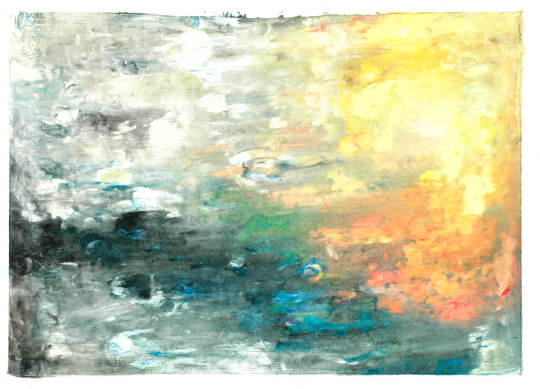
By simply lifting the screen by placing tape underneath, we were able to freely pour and paint images that we wanted to on the paper.
This was one of the mock-ups I made by using screenprinting paint and printing medium. I tried using a 50:50 ratio in mixing the paint and used a brush to manually paint onto the lifted screen to give more texture.
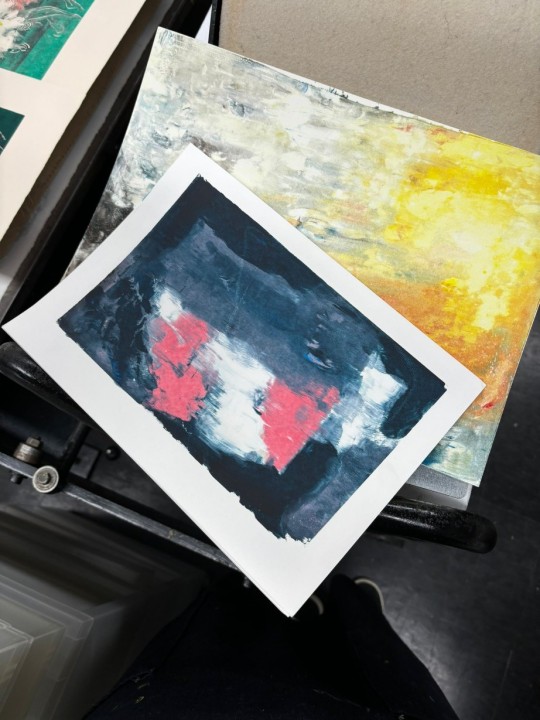
The pressure of the squeezy allowed to transfer of the paint on the screen to the paper quite smoothly. And we were able to closely achieve the 'painterly effect' like Helen's work.
ASE Arty Afternoon
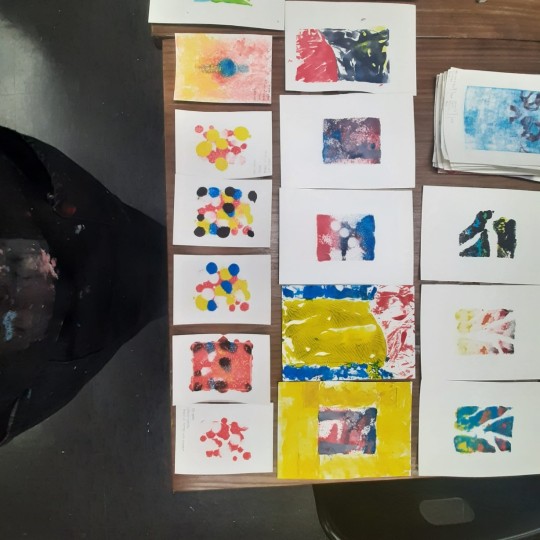
For the upcoming exhibition, "Artsy Afternoon" was a free walk-in workshop where participants could learn about the techniques used in the exhibited works and get hands-on experience with printmaking methods they might not be familiar with.
To maintain the essence of the workshop, it was crucial to keep the activity simple, quick, and cost-effective. We experimented with various mock-ups using cotton balls, foam, brushes, and flat foam, applying water, colors, and even cutting the foam into different shapes to add variation.
Papermaking Class: Pulp Manipulation with Text Workshop (May 4 & 11)
For the "Papermaking Class: Pulp Manipulation with Text" workshop, we were responsible for checking in participants by confirming their names against the signup list and guiding them to the workshop area. It was important to track attendance for future reference, noting who attended and who did not.

We noticed a shortage of containers to pack the participants' completed work. On the day of the workshop, one of my colleagues went out to purchase more containers, visiting multiple vendors across different locations, while the rest of us stayed behind to ensure the workshop ran smoothly.
In total, we managed to gather over 300 containers that day. It was particularly challenging because of the rainy weather, which made the task tricky and cold. It took quite some time for my clothes and socks to dry afterward.

Admin
We began cleaning up and reorganizing outreach emails in Outlook. The daily influx of emails was overwhelming, so we organized them into folders and categories. By taking inspiration from other departments' email systems, we created a more efficient structure. This not only streamlined our inbox but also made it easier to locate resources and past emails for future use.
Additional tasks to be completed gradually include:
Preparing for the Indian woodblock workshop for the June holiday program
Preparing copper plates for the ASE workshop
Polishing wood tools for the ASE workshop
Photo courtesy of STPI Creative Workshop & Gallery
0 notes
Note
Hi. Is it alright to request fluff with Dr.Ratio and a blind s/o who is a genius musician in modern au? Thank u!
A/n: Hello! I hope this is what you had in mind when you requested this, I feel like I got something wrong lol please enjoy!
Contents: Dr. Ratio x GN! Genius! Reader, can be read normal au - can be read as modern au, tinge of angst at the end if you squint
Ko-fi

-It wasn't a rare story to hear, the blind genius that plucks cords and presses keys better than any musicians has up to date. Yet, with all that renown and reputation, you remained an enigma among the masses
-How did you do it? Why? When did you become a part of the genius society even? What did Nous see in you? Was it just a taste for music?
-You always walked around with some string instrument in hand, plucking the strings quietly and softly - making people believe those were your eyes, you saw using music. And perhaps they wouldn't be too wrong to believe that. Maybe you just had great hearing?
-But were you not a genius you wouldn't be a part of the Genius Society. That's for sure, and it goes for the way you deal with everyday struggles and issues.
-He was just a renowned professor, known for his hardwork and strictness.
-Dr. Ratio refused to be impressed until he met you for himself, withholding his judgment for later.
-Getting an audience with you seemed impossible, you kept to yourself and kept yourself busy with your own work and research, and from time to time you’d take in some orchestra on your planet. Music was your way into the world, music was your eyes, your nose and your taste all in one, it was your language and something that you kept dear and near.
-It wasn’t surprising to know that your main field of research was of auditory nature, different species hear differently, but what about the creatures and organisms humans can’t naturally hear, do they make noise too? Water is known to hold feelings in some capacity, and different tunes being played to the water before being frozen impact its structure at the end.
-It is a magical sort of research, but you know there is no magic involved at all. Just natural reactions.
-Dr. Ratio was impressed to say the least after he witnessed you play the instrument, one of rare instances that you accepted into being on stage yourself, a performer instead of the spectator. You possessed a good ear and a better hand, everyone fell in love and was in awe with the sounds produced.
-Afterwards, Dr. Ratio tried his best to hunt down a private audience with you, he had many questions regarding your research and your character overall. He wished to understand, to know.
-Yet all he could do was watch, always so close yet so far, you always remained just out of the hand’s reach. Somehow you evaded him.
-For all your lack of eyesight, you knew the best route to avoid him, he had to ask whether it was intentional or not. Was this also some extension of Nous, the aeon that neglected his presence entirely?
-He ended up sending a formal invitation for a talk to you in the end, directly to you, and at long last you accepted.
-Dr.Ratio never felt so nervous. He stood in his room, getting ready for this outing and eternally he questioned himself, his state of mind, why was it all cluttered, why were his palms sweaty and why could he just not think straight.
-All those came to an ease once he neared the meeting point, hearing the familiar melody of the strings your fingertips so diligently pulled. His heart swelled with relief, and for a moment he didn’t have the heart to speak up, not wishing for the tune to end. Dr. Ratio had an eye for art himself, and you were the new masterpiece he found, you and your art.
-He dares say he loves listening to you play, it makes him wish to go back to his own instruments that are gathering dust at home, he wonders if you’d let him join you in a duet once, perhaps? Perhaps not? He is not a Genius, but a Mundanite, and you were everything but average.
-Perhaps one day it could be you to answer his eternal question.
-Maybe one day he will be able to feel a fraction of a genius as you.

Ⓒ n0tamused. Do not repost, translate, edit, and/or copy any of my works. Likes, comments, and reblogs are appreciated.
#honkai star rail#hsr#honkai star rail x reader#honkai star rail x you#hsr x reader#hsr x you#hsr x gn reader#hsr dr ratio#dr ratio x reader#dr ratio x you#veritas ratio x you#veritas ratio x reader#veritas ratio headcanons#dr ratio headcanons#gn reader#genius society#hsr imagine#hsr headcanons
181 notes
·
View notes
Text
Week 1
To kick off the live local project, I decided to read all of the texts given this week. Starting with "Design for inclusivity 01" (Preface). In essence, the piece provides background on how main design principles have evolved from the beginning of the 20th century, continuing on to the current day. Consumerism and sustainability and the impact projected onto society as well as the planet seem to be present throughout all periods.
One term that I was not familiar with was feminist design. After doing some research into its core features, I realised that this type of design aligned very will with our course and methods of working. MIT Press have published the book "feminist designer" which describes feminist design as a collaborative process that aims to disrupt and dismantle power hierarchies, putting feminist ways of knowing and doing at the centre of design. if possible, I think this resource could be valuable to the course/my research and I will investigate the book to see if there are any copies within the university.
"Design for inclusivity 02" stresses the importance of having the needs of those with disabilities at the foreground, acting as a baseline rather than an afterthought. Especially in the 65+ age category, I think this will be essential as there could be a higher ratio of disabled attendees to able attendees in comparison to any other demographic. The extract notes the reduction of eyesight, hearing, mobility, dexterity and cognition as we get older. When exploring the accessibility of my workshop, I will use these points as a starter. The core of inclusive design surrounds the user's experience, understanding identity, emotion, delight and self expression. This particular section inspired me to think of ways to provide the group with a creative outlet where they can express themselves without judgement from others or even from themselves.
From the notes I had taken from the presentation delivered by Emily at the MAC, I had gathered the three main reasons that people attend the culture club is to socialise, keep their minds active and try new creative activities. This will be what I refer back to when brainstorming for ideas for the workshop. The demographic of those aged 65+ was described as people who mostly attend with friends or partners, those who are active and independent, mostly women, and have a minority of those who are disabled.
By having an example schedule that the club usually runs by, containing different segments to create the whole workshop, I can use a modular design approach discusses in design for inclusivity 02 to ensure the layout of my workshop is accessible to all attendees.
On the Wednesday session, I began to brainstorm ideas for my workshop. As I knew I would be away week commencing 25th of September, I felt as though working by myself would be the best option so that I can catch up on my work when I get back and others won't be relying on me to complete work/ they won't have to put extra work in to complete tasks.
To begin my research, I calculated when those who are 65 were teenagers. this was to give myself context of what they grew up with and would almost give me a boundary of what the group would be familiar with. This would put us into the 1970s. As the demographic is 65≥, I investigated what worldly events were taking place in the 60s, as well as looking into pop culture of the decade.
The 60s held the post WW2 economic boom, leading to what was known as the golden age of capitalism. employment of the population increased alongside consumerism, the space race (moon landing was in 1969) and second wave feminism.
0 notes
Text
Interim Crit Project B (4/5/23)
My concept art project idea pretty much started from one character design which I then developed a world around.
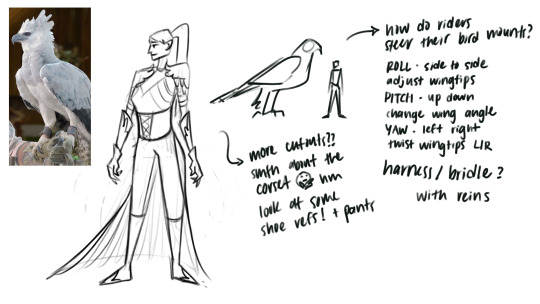
I've always loved birds, especially birds of prey like eagles, hawks, falcons, owls, etc so I wanted to design a character that was based on one. I took an image of a harpy eagle and incorporated characteristics of the bird with medieval fantasy armor. I wanted the armor to have pieces and flourishes resembling feathers, and the knight to have a cape like a feathered tail. The gauntlets are sharp to imitate the talons of an eagle and the overall silhouette is pointed. I kept shape language in mind and wanted the character to have a triangle shape to emphasize her dangerous nature as a warrior.
I think I ended up choosing a fantasy inspired genre because I've been reading a lot of fantasy books in the past few months. I used to be a really avid reader through elementary and middle school, and my favorite genre back then was anything to do with dragons and talking animals. One of my favorite franchises ever is How to Train Your Dragon, both the book series and movie trilogy. I fell off reading books when I started high school because the internet was much more accessible by then, but for 2023 I decided to get back into it!
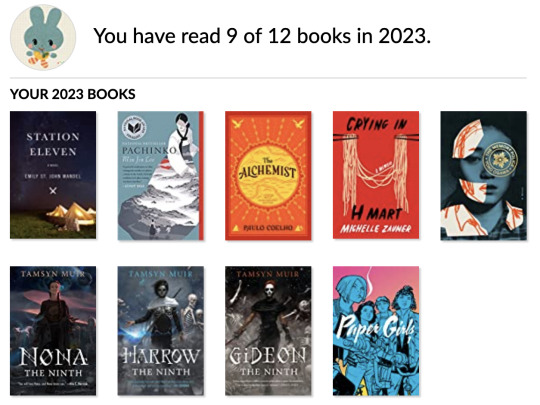
So far my 2023 Goodreads challenge has had a pretty considerable ratio of fantasy books, specifically the Locked Tomb series starting from Gideon the Ninth. The Locked Tomb is a bit of a mix of fantasy and sci-fi, but knight cavaliers and necromancer sorcerers are pretty central to the story, which definitely led to the knight decision.
From the character design, I started thinking about what kind of world this knight could inhabit and why would her armor be so heavily inspired by birds. The two main influences that I combined to create the world this character design by Airi Pan and the Great Eagles from Lord of the Rings.
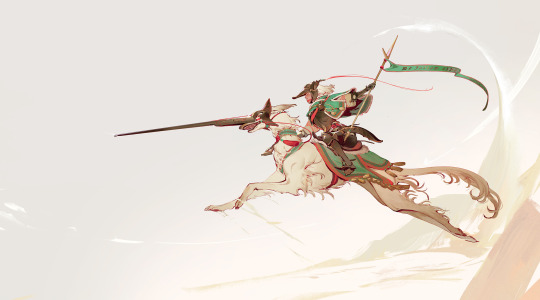
I love the idea of taking any animal and having it become a knight's trusty mount, and the Great Eagles already set precedent for large birds that can be ridden, so I decided to create a world based on the concept of eagle knights.
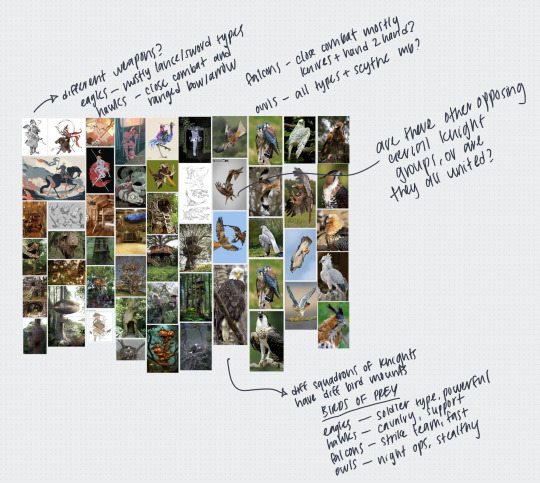
I started gathering references for the influences that I want to go into the world, from fantasy medieval knights to birds of prey, to treehouses and bird nests. I took notes on areas that could be fleshed out for worldbuilding purposes, thinking about different classes of knights and their different bird mounts.
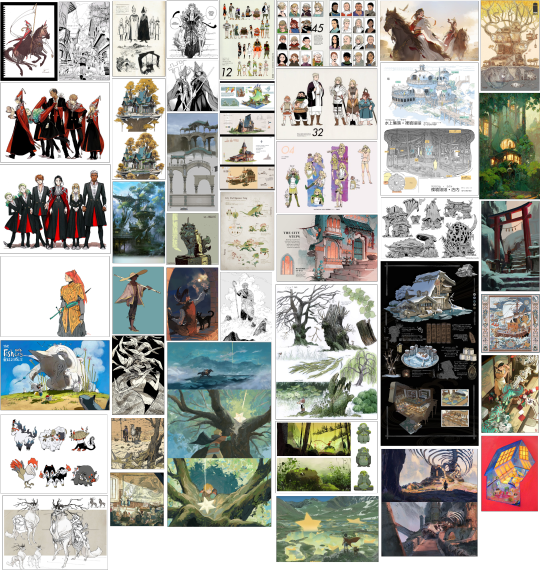
Next, I also created a reference board of visual development art. I wanted to have a lot of different types of concept art to reference and prompt me to think of different aspects of worldbuilding. Two manga titles that really inspire me are Witch Hat Atelier by Kamome Shirahama and Dungeon Meshi by Ryoko Kui. Both are manga series written and illustrated by women, and are set in incredibly lush fantasy worlds.
I was inspired to start reading Witch Hat Atelier after hearing that it has great representation of disability and darker skinned characters, which is really rare for both the fantasy genre and Japanese manga. The character designs in Witch Hat Atelier are gorgeous and fantastically diverse, yet cohesive in a way that I really appreciate.
youtube
I picked up Dungeon Meshi after watching this amazing breakdown video on character design in the series. Ryoko includes extras in some of the volumes which demonstrate her great attention to detail in character design. Her character portrait lineups show diversity in their facial features and physical makeup, and she also makes sure that even when her characters have swapped costumes, they're still distinguishable from each other. There's a large range in body shape and size in the cast, even for women, whom Ryoko isn't afraid to design outside of the typical beauty ideals.
Besides character art though, I also have environment designs and creature designs in my reference board. I think it's important to have sheets that describe the detail of specific environmental details in a technical way, but also more rendered paintings that establish the mood and atmosphere of a world.
0 notes
Text
Parts and part crafting
With ~250 robot parts in the demo, there really had to be some way to reliably obtain them by the player! Now’s the perfect time to talk about it, as I have just finished my first pass at adding crafting costs to the parts.
But first, what exactly is a part? Well, it’s these:

Each part’s visual appearance and functional design is taken directly from the robot that drops it. Parts are classified into 1 of 4 types, in the picture from left to right, these are: weapon, frame, mobility, and support.
As you can imagine, weapons focus on attacks and offensive stats, frame parts focus on defensive stats and element affinity modification, mobility parts focus on speed and turn order manipulation, and support parts are varied - scanning, energy management, ammo management, buffs, and debuffs are just some of the roles they perform. Of course, within each category there are mold breakers so it’s up to the player to assess them and equip them to the right robot.
Different to other RPGs where you might have 1 slot of each type, here, all robots have varying numbers of each part slot type which will determine how many of each part they can equip, and ultimately their combat role. There’s also a rarer universal slot type where, surprise, any part can be equipped there! In addition, a robot has a total power load (which increases as it levels up.
Parts have a power value, which fill the power load. You can indeed go over the maximum power load (i.e. overloading the robot), which will decrease its stats proportionally to the amount that you’ve gone over. It’s up to you to weigh up the benefits of that shiny new part’s abilities and whether it’s worth overloading your robot!
So, now that’s out of the way, how does one acquire parts?
Well, the main method a player will use is naturally, by fighting enemy robots! Enemy robots have a chance to drop their associated parts, and a much smaller chance for that part drop to change into a different (but related) robot’s part.
If you find you aren’t dropping what you need, the second method is crafting. A set of parts is unlocked for crafting once you recruit the related robot for your team. A singular part is also unlocked for crafting the first time you obtain it, too.
Parts can be crafted by first researching the crafting station, and then using the appropriate materials and scrap (the game’s currency). Simple! What wasn’t so simple is determining what sort of cost each part should have.
The way I went about it is by first defining up to 3 material types to be used for a part. These materials tie into the gathering system I have programmed so I won’t go into it too much here, but materials are broadly broken up into two types: natural (iron, titanium, lead, copper, gold, silicon, uranium, etc.) and artificial (polymers, plastics, alloys, glass, ceramic, wiring, circuits, sensors, batteries, CPUs, actuators, etc). Artificial materials can also be crafted at a 2:1 ratio from natural materials.
Here I really tried to define the flavor of each part by having parts of a series use the same sorts of material. I did a quick pass to make sure materials were roughly being required in equal proportions, but this part was really mainly to give the player a sense of how these parts were made, rather than having a balanced usage of materials.
For the material costs, I was a bit more rigorous. I first looked at the power load, which was already essentially an aggregate score of a part’s overall effectiveness. A higher power load meant a part gave more stats, abilities, or shifted elemental resistances more favourably. Naturally, as part slots on robots are precious, the more things a part could do, the more valuable it was and so the more materials it should take to craft.
I made sure that the power load divided by the total material cost was roughly 2 (e.g. a part with a power load of 14 would take on average 7 materials to craft), with power loads above 10 having a slightly worse ratio, and under 10 having a significantly better ratio than 2. I then allocated values to each material flavorfully - e.g. a plasma cannon might take 5 titanium and 1 exotic matter, while a warp ring might take 1 titanium and 5 exotic matter. I plan to shift the power load to material ratio to match the rate at which players gather materials, once I begin playtesting.
The scrap cost was calculated in a similar manner. First I determined that on average, players would get about 100ish scrap per battle (each enemy is worth 20 scrap on average, players will be fighting between 3-6 enemies depending on their depth in the dungeons). So 100 was the base cost. Then to that, I added some extra costs based on the power load, the number of moves, and the number of resistances, all to the power of some number. Again, this was to reflect more stuff on the same part = good, and exponentially so! I’ll obviously be adjusting the values once I see the actual scrap gain from battle vs my estimates.
So there you have it, just repeat that process times the 250 parts in the database, and done! What I still have yet to do is program the way part recipes are unlocked, as currently everything shows without restriction. I also need to add some filters (by part type, tier, and whether a part is providing stats/affinities/moves) to the interface because, well, as you progress through the game, there’s going to be a lot of recipes to scroll through!
Thanks for reading! Once I’ve implemented the above, I’ll record a video of the whole process for you all to see!
#game#videogame#devblog#gamedev#scifi#spacegame#dungeon crawler#rpg#entropy#gamemaker#programming#pixel art#robot#indiedev
30 notes
·
View notes
Note
pls pls pls where are you? we need your expertise to analyse connor mcdavid's house <33
im so honored you asked omg thank you <3
let's star with the facade

i really don't like the materials it makes it look kinda cheap which i'm sure it's not, i would've gone with an exposed concrete like the driveway floor
but apart from that i really like the composition, the asymmetry with the two porches, the bigger one being retracted from the smaller one, i like the clean shapes, i'm not a big fan of having that many windows because i feel it unbalances the wall-openings ratio (plus then you have to add a bunch of curtains for privacy) i also don't like the garden but i don't know about landscaping
now let's see the back facade or whatever it's called in english

now this is the kind of wall-opening ratio i would use in the front of the house for privacy reasons and i would put the big windows to the back to you still have all that natural lighting and connection with the nature and not everyone that walks by can look inside your home
also i really really really like the way they continued the prism to put it some way, those lintels and column on the right corner they didn’t need to keep them for structural reasons but they did to not break the prism that is the house and it looks like they cut out a part, i love that i'm gonna use it in my next project
also i love their dog
now let's talk about the interior
from what i could see it has an open floor plan, there aren't many hallways or walls it's more like one huge space created by different spaces all connected that flow from one to another, i really like that, really modern and really like social in a way, you can have many people and ll be in the same room really good for gatherings and kind incites collective life to put it somehow


there's also a lot of natural light which we love, i really really like when the windows take up the whole wall (sorry don't know the term in english) makes the space seem bigger and creates a great connection with the outside blurring the line between interior and exterior

then regarding the decoration i'm not an interior designer so this is purely just what i think and like, i don't like it
she's an interior designer so i'm sure this is like super tasteful and extremely well thought and everything but i just don't like it, it seems really cold and impersonal and idk it doesn't feel like a home you know feels so impersonal (i remember there was this joke going around that it's a serial killer house and like yes i get that vibe)
i have to admit this really depends on the room like for example the main living room (first pic) i don't like it, but this secondary living room or whatever it is (seconds pic) i really do like and it seems more warm


however i have to say i like the way she stayed on tune with the architectural aspects when it came to the design, she chose an earthy palette with different metals and greys and browns that really combine with the house textures and materials of the house, also she kept the whole clean geometrical shapes on the furniture
but overall architecturally i like the house, really modern and stylish
also let me add im just an architecture student everything i said is just my take so yeah that keep that in mind
ok this was way way waaaay longer than i thought it would be sorry i really like rambling about architecture
16 notes
·
View notes
Note
I love seeing your book-binding photos, that is such a cool idea to make neat physical copies of fanfic and webnovels! I also want to start doing that now, but I'm not quite sure where to begin tbh
The good news is that it’s a lot easier to get started than it looks! Even a fully casebound book isn’t nearly as difficult as it looks. Every individual step of the process is surprisingly attainable, and imho the biggest barrier to entry is the number of small items you need to gather together to make the whole thing happen. My dad was the one who introduced me to this hobby, by means of just printing out like ten-page pamphlets with material he needed to reference for work, and folding them in half and stitching them together, so it can really be that easy to get going! But in terms of resources, I’ve found videos to be the most, most useful, so let me pull some links up.
So the two main youtube channels I’ve reference have been SeaLemon (more diy oriented, less intimidating, lots of cute videos for shorter notebooks, which can also apply to shorter fics) and DASBookbinding (more oriented towards casebinding books, and honestly, one of the best resources I’ve found period)
Now, before getting into the printing-fics-specifically part, let me take a detour, because the printing is heavily dependent on what specific software/hardware you have access to. So first, just the mechanics!
SeaLemon’s videos are something I recommend a lot to beginners, because most of her projects are pretty bite-sized. She has a video on casebinding that I referenced at first, though now I mostly reference other people. But she does good overviews of the basic steps that are easy to follow, and some of her short projects like the japanese bookbinding or single-section bookbinding are really attainable, and require much less of a craft supply commitment than a full casebinding project. (Once you do reach casebinding, I do recommend her video on converting cloth to bookcloth. there are ““proper”” ways to do it with homemade paste, but like, i live in a carpeted apartment, i only have so much space to work with and so much carpet that doesn’t belong to me to ruin)
Now, I do find DASBookbinding extremely good, if overall more intimidating than SeaLemon, but also his latest pair of videos are about just... making a pamphlet. He’s a great resource for the complicated stuff, but he does cover the basics too, and is just FANTASTIC. I definitely did some short pamphlet-sized stuff early on, to get a grasp on ‘okay, this is how I sew a signature together’ and ‘okay, this is how I sew multiple signatures together’, before going into the bigger, more complex cases. I’m not sure which videos of his to link, because they’re all great and cover a ton of ground, but! As a good transition point, he does have a video on how to print individual paper signatures from a pdf file
So! Printing! Printing and formatting go hand in hand, and I’m not well equipped to speak to the different options out there, because I’m comfortable in Word and am fortunate enough to own a color laser printer. I did start out using google docs and printing to pdf, then printing from adobe acrobat in booklet mode to my printer, but that means the aspect ratios are wrong and my margins are huge, and google docs chokes on large files anyways. I’ve seen people format text for printing in Word, LibreOffice, Adobe InDesign, LaTeX, and I’m positive there are other options. I know some people work from inkjet printers, and some work from single-sided printers and flip pages themselves, while other people make use of access to university printing services or places like staples or kinkos. I’m not properly aware of the range of options out there, so I don’t want to make definitive recommendations, but those are things I’ve seen people doing.
But even if you don’t have formatting software or printing equipment at hand, it’s really surprisingly easy to take blank sheets of paper, fold them in half, and start experimenting with making a notebook. Broadly speaking, I recommend picking a video tutorial you like, watching it and making note of what tools/supplies the person uses, and following the steps on your own. There are... a lot of tools and supplies that go into things, but none of them are that expensive or that hard to find. Other than replacement toner cartridges for my printer, the most expensive thing I’ve bought is a cutting mat. And seriously, I am absolutely in love with this hobby, and recommend it to anyone who’s interested. Even if you never feel like trying something more complicated than a soft-backed pamphlet, there’s something profoundly satisfying about holding a book, whether it’s empty or filled with a story, and thinking I made this.
52 notes
·
View notes
Text
So I’m sure y’all (ben 10 fans specifically) know about the episode Inspector 13? And how Gwen couldn’t used her mana like she usually does?
Yeah, those are my thoughts today and I’m gonna talk about ‘em.
Let’s get this out of the way first, pure full Anodites will not have the same trouble that Gwen has, regardless of form. Basic reason here same as normal, they’re pure mana and Gwen is a fleshy human with a spark, so inherently there’s already a difference in the flow of mana.
But are other species capable of magic and mana manipulation?
Heck yeah!
Knowing what we’ve seen with Anodites already, sans Gwen of course, they’re the... uh... hmm let’s say playboys of the universe. Much in the same way that humans can’t keep it in their pants, Anodites don’t have pants in the first place and would definitely proliferate with life spanning galaxies. And just like with humans, there is a chance that any hybrid child of an Anodite can have the spark.
But does that mean that Gwen can use mana as each of the aliens she turns into?
Heck no!
At least not on first try.
Now let me explain. Humans have a filter on their flow of mana, one which Anodites don’t possess, but other species have that same filter. Why? Well, it’s their DNA of course, it’s what separates them from the pure energy beings of Anodites, the unfiltered raw flow of mana. This filter is there because while Anodites are filled with mana, a hybrid with a spark produces their own unique life energy that interacts and mingles with the flow of their mana.
But what does that mean for Gwen?
Given that the spark is not... uh... entirely genetic (there’s a need for an Anodite SOMEWHERE in the bloodline for the spark, but it doesn’t come up in DNA), it should exist through each transformation. But the issue here is that, while the spark stays the same, the filter wildly changes.
Gwen, as herself, is athletic and light on her feet, so her mana floats, twists and turns, and when solid, is akin to glass. But as Diamondhead, suddenly there’s more weight and less dexterity. There’s a difference that opens a new set of rules for Gwen that she’s never had to deal with, and just like at the start of her magic career, things don’t work exactly as they should.
I’m done with the whole analysis side of this thought, but the main reason why this is on my mind is because... well... I didn’t like how the show handled the differences in mana manipulation. It’s maybe a sneaky little episode rewrite, and maybe a little more interesting version of the ‘getting-used-to-another-person’s-powers’ trope... which I’m pretty sure is a thing. I don’t know I’ve seen it before a few times so whatever.
ANYWAY! Moving on to what I would’ve like to have happened, let’s go in order of Gwen’s transformations.
As stated (and is obvious), Petrosapiens aren’t very known for their light weight and dexterity, so one’s magic would reflect this. How this will affect their mana would turn the free flowing looseness of floating mana into physics based materialisation. But what makes this different to a Petrosapien’s natural crystalkinesis?
Let’s demonstrate with Diamondhead.
A falling Gwen would realise quick that her attempts at making platforms would fail, seeing them fall alongside her. However, producing these solid objects took nothing away from her physical levels of energy, meaning Diamondhead wasn’t growing fatigued unlike with typical crystalkinesis. Gwen would have the ability to form as much ‘crystals’ as she wants in order to keep her from crashing too heavily into the ground.
This use of mana is more so built upon traps, because they last a lot longer and barely need concentration to work. Used as a replacement for crystalkinesis, a Petrosapien ain’t gonna get very far, because these ‘traps’ work on everyone even if they can disperse the constructs. No, it’s better to stay away from the constructs because they amplify sonic waves (the mana vibrates as if like a tuning fork) and can create shatter explosions if struck the right way. For the latter, if y’all have seen the dude pressure plating a diamond, it’s like that.
Now, let’s talk about the second alien Gwen transforms into, Clockwork!
Chronosapiens are a little more robotic than Humans and Petrosapiens, especially Anodites, so their filter of mana is a lot larger. It is the fact that they are alive in the first place that let’s them use magic at all, but their mana capabilities are extremely limited. It’s like being trapped in a metal suit, where it’s hard to allow the internal spark to manipulate the external environment. But what if one doesn’t use external magic?
Clockwork can work like this.
Gwen may not manage to bypass the filter and create mana constructs, or even a flowing tendril, but she can find ways for her modified magic to work. Clockwork keeps the spark internally, so why not help that along with less offensive and defensive skills, and instead more utility casting. What does this mean? Flight, babes! But instead of the traditional sort of flight, Gwen finds that she can ‘walk on frozen time’ and ‘slip through the seems’.
Okay maybe that sounds a little too much like the Esoterica power set, but it’s not like seeing a fourth dimension and accessing the inaccessible. It may appear to be the same, but just like how people may perceive Clockwork to have super speed, even though he’s just slowed time for everyone else, it’s just a matter of perspective. But in general, learning to use mana outwardly would need more time than Gwen had.
Moving on to alien number 3, we have Humungousaur.
Now, in terms of filters, Vaxasaurians have a little more access to mana manipulation than Petrosapiens and especially Chronosapiens, but they have a whole lot of life energy due to their size, which has an effect on their spark. While the dexterity of their magic can be comparable to Human’s manipulation, the strength of it is quite limited, so while a Vaxasaurian may be dependent on their physical bodies for attack and defence, magic is just a bonus action.
So how would Humungousaur use magic instead?
Well, while Gwen would engage in a good old round of fisticuffs, she can use mana like a lasso/whip to trip opponents and yank them this way and that. And by ‘this way’ I mean directly into her punch, like you’re the ball of a paddle-board. It’s definitely more of an assistance type of magic, and it’s definitely not strong enough to support the weight of Humungousaur, but Gwen can control the battlefield by controlling the stability of the enemy.
Think hunting and gathering, this is where a Vaxasaurian’s magic thrives, where it helps with restraining and retrieval rather than attack and defence, they’ve already got THAT down. Prime Vaxasaurians, with their size increase, would lose the use of their mana when at max height, but Reboot Vaxasaurians can emphasise their tail shockwave with magic to make it even more deadly.
Up next is Upchuck, and boy is this an easy one.
Gourmands already have a natural relationship between themselves and energy, so someone with the spark can super enhance their energy bile. To the point where it’s almost unnecessary to actually eat anything to get at least some sort of fire power. Of course, with a Gourmand’s small squishy body, they are perfectly capable of throwing up defences (I swear that pun was an accident), but who needs defences when you’ve got a whole arsenal of explosive mana.
But there’s a little issue with Upchuck that Gwen has to get over.
The problem? Gwen’s a little self-conscious about a Gourmand’s abilities. Mana is the flow of life energy, so if the flow is restrained by embarrassment, it doesn’t act at its full potential. Upchuck can certainly try to use magic as a crutch to avoid needing to eat and spit her way in, but the free flowing stream cutting off is inhibiting the strength of her defence too.
SO! When Gwen finally caves and eats some metal, there’s enough power to blast a hole into the techadon factory big enough to get inside with time to spare. Aside from enhancing the blasting power of a Gourmand’s natural energy, the use of mana manipulation can change the ‘weaponry’ of the attack, which can turn into a gassy smokescreen (burp) and a sticky ball (loogie) to name a few. A Gourmand’s best strength is confidence, so Gwen would need to adapt her mana the same way.
And last but not least, we have Rath stepping up to the plate.
Now, Appoplexians are... rather straight forward and fight tooth and claw rather than strategically. They have a similar mana to life energy filter ratio to Humans, but that doesn’t mean that they’re just as magic friendly. Mana manipulation typically requires coherent thought other than the urge to beat someone up.
But Rath can use magic, and here’s how Gwen works it.
Cutting to the chase, there’s no range mana attacks, at all. For one thing, Rath would find it cowardly, another being that unlike ripping out a turret and throwing it at something else, there’s not enough brutal violence. And utility magic is not even considered. That needs some planning, and the only plan Rath has going into the fight is to WIN! And Gwen is not immune to the urge for violence.
So what happens instead, Gwen would accentuate a punch, slash or block with the extra kick of mana. Enemy fist approaching at 5 o’clock, t-minus 2 seconds? Mana armour. The techadon warrior is regenerating a little too fast for liking? Mana blade! Inspector 13 is being an annoying little techadon engineer with his constant downplay of their abilities? MANA PUNCH!
And after all that, Gwen gets to be in her own skin again. Some of the abilities she learnt that day don’t translate to her Human form. She can’t form crystal traps, she can’t slip between the seams of time, she can’t modify the properties of her mana. But some of the techniques she learnt can be adapted into her regular fighting. She can manipulate the battle field, she can construct armour on the fly.
But most importantly, she can see the differences of life energy, and how they effect magic use. Seeing a range of different mana manipulation, Gwen has unlocked a more open perspective on magic and can learn so much more, her expectations of Human magic pried open wide.
I think THAT would’ve been neat.
But instead we got same face syndrome not to rag on the episode haha.
#gwen tennyson#anodite#petrosapien#chronosapien#vaxasaurian#gourmand#appoplexian#ben 10#Inspector 13 episode#headcanon#ramblings#a vague sorta#rewrite#but like not entirely#just a little bit of complaining but i just wanted to look at magic
28 notes
·
View notes
Text
polygyny, infanticide, and conflict in sexually imbalanced hunter-gatherer populations
content notes: rape, infanticide, murder
Hunter-gatherers’ primary method of population control is infanticide, and they preferentially kill female children. Some of the reasons are that men are more useful for defending the family and tribe (women basically never fought, although this changed a little bit after archery, except in home defense), and for obtaining food, especially in areas (like the Arctic) where foraging yields much less than hunting.
So, how strong is the sex imbalance?
Infanticide is often covert and attributed to accidents, but census statistics of pre-industrial societies tell an unmistakable story. Although the number of male and female babies should be nearly equal at birth (105:100 in favour of boys), there are many more boys than girls in childhood. Surveys of hundreds of different communities from over 100 different cultures (of which about a fifth were hunter–gatherers) has shown that juvenile sex ratios averaged 127:100 in favour of boys, with an even higher rate in some societies. The Eskimos are one of the most extreme cases. Their harsh environment made them wholly dependent on male hunting, whereas female foraging played a greater economic role in milder climates. Thus female infanticide was particularly widespread among them. They registered childhood sex ratios of 150:100 and even 200:100 in favour of boys.
So, this is awkward, because fighting over women is one of the primary causes of hunter-gatherer conflict and warfare. The standard objective of a raid – the primary form of lethal conflict across hunter-gatherer societies – is to kill all the enemy men, grab their stuff, and kidnap the women. There’s a quote from an Australian hunter-gatherer man asked by an anthropologist whether his motivation for a raid was food, and responds, ‘Even though we like meat, we like women a whole lot more!’ In unfortunate addition, the more insecure a society is about warfare the more it’ll prefer to have male children:
In this way, as statistical studies show, male and female numbers in primitive societies—highly tilted in favour of males in childhood—tend to level out in adulthood. Violent conflict is thus one of the principal means through which competition over women is both expressed and resolved. Furthermore, as Divale and Harris have shown, there is a vicious circle here: in societies that lived under the constant threat and eventuality of violence, families’ preference for males who would protect them increased.
Note that it’s not just that you can resolve competition by kidnapping your enemy tribe’s women – in the process of going to war, some men on your own side will die, decreasing the competition pressure.
Cool, cool. So, competition for females is a primary driver of hunter-gatherer warfare. Time to have... polygyny!
Polygyny was very common in hunter-gatherer societies – although approximately the majority had one wife, the most powerful men almost always had multiple, and the wife Gini index goes up the more resource-dense an environment is. “There was a direct correlation of resource density, resource accumulation and monopolization, social ranking, and polygyny.” – the more resources you can accumulate, the more mouths you can feed in your family, the more clout you can have in your community to take more wives without resentment blowing up. In the resource-scarce Kalahari Desert, !Kung men are largely one-wife, but 5% of married men had two wives. The case is similar among native Eskimos in the mid-Canadian Arctic. In contrast, studies of Australian tribes say that 10~15% of married men have three wives. In even more productive Australian land, a few men hit double digits of wives. As you may guess:
Polygyny greatly exacerbated women’s scarcity and direct and indirect male competition and conflict over them. Indeed, a cross-cultural study has found polygyny to be one of the most distinctive correlates that there is of feuding and internal warfare.
Incidentally, this makes the question of when and how monogamy became so entrenched as the default in Western society fascinating to me, because it seems incredibly useful – I assume it mitigates a primary source of violent conflict, and helps large-scale societies hold together. I wonder whether it’s linked to the success of Christian societies.
The fact that the male/female sex ratio is so (artificially) imbalanced to start with but levels out as men die off seems to have affected the timing of male puberty.
As mentioned earlier, among the victims of male competition for women are the young adult males, who are obliged to postpone marriage for quite a long time. This universal and probably very old trend among primitive human communities has some interesting evolutionary consequences. Men reach sexual maturity at an older age than women, which is quite the opposite from what we would expect in view of the fact that man’s reproductive role and reproductive organs involve a much lighter physical burden than the woman’s. The main reason for this later male maturation seems to be male competition. Men are given a few more years to grow up and gain strength before being exposed to potential violent conflict.
237 notes
·
View notes
Note
How do I get around with designing a high school? Mainly the buildings but is there anything about the social setting that I should take note of?
Tex: My knee-jerk reaction is to go “well, just look at a high school”, but I realize that’s not a helpful answer, particularly when you get into the details of a thing.
It helps to have an orientation point, and for the purposes of architecture, that means the goal of your design. Sometimes high schools are a single building, sometimes they’re multiple buildings. Some have parking lots or garages, some do not.
A lot of this depends on the era and region your school is built in. High schools are a relatively modern inventions, as is standardized education for minors - particularly for all social classes. This has an impact on how conservatively or lavishly the campus is budgeted, and what sort of materials they use.
One thing to keep in mind is that there are different types of high schools. As it is the last stage of, in modern terms, state-mandated education for minors, quite a lot of countries switch gears compared to the schools for younger children's by focusing on training these students for jobs. This can mean anything from a preparatory school to a vocational school to the plethora of other names secondary school acquires according to country.
Because of this, figuring out how each cohort is divided (e.g. incoming year to exiting year of students), along with any particular particular programs (e.g. the IB Diploma Programme or the Advanced Placement program). Buildings may be divided up by activity level (lecture-based courses versus sports/physical education), by subject matter (STEM versus humanities), or by grade (each year cohort in its own building).
This is of course dependant upon how much land a school has funds to purchase - or has been allocated by the government - as well as such issues as number of competing schools in a given zone or academic concentration (e.g. vocational or preparatory schools), which inherently eats into the budget regarding issues such as materials, building size, and miscellaneous amenities (such as bathrooms and cafeterias).
Social setting depends on budget. With a good budget, a school can get things like grounds with amenities (e.g. fountains, benches, and other architectural elements for social gatherings), large indoor areas dedicated to socialization (e.g. libraries, common rooms, cafeterias with indoor seating, exercise rooms). With a poor budget, land outside the buildings proper may be relegated to a dirt lot or paved area for parking, possibly with some benches/tables or some shaded areas where room permits.
An expected high volume of students, generally, nets more income for the school regardless of where the money comes from. The more students there are, particularly when planning for building is still being developed, the more accommodations are made outside of mandated minimums (e.g. handicap accessibility, general volume-to-size ratios). If there’s an unexpected increase in student enrollments, particularly for a sustained time, this would put a strain on the campus and could cause general disrepair due to the increased wear and tear caused by student enrolling over maximum designed capacity.
There’s a myriad of other concerns for designing a school at any level, because it comes with its own particular complications of being (ideally) a hybridized space defined by multiple focuses. I’ll list out some links for you to read, but this is unfortunately a many-pronged subject that would benefit from more specific questions.
Further Reading
Infrastructure - Wikipedia
Facility Planning: Design Mismatch by James Rydeen - American School & University
PDF - Forum Guide to Facility Information Management: A Resource for State and Local Education Agencies - National Forum on Education Statistics (2018 version)
How crumbling school facilities perpetuate inequality by Mary Filardo et al - Phi Delta Kappan
The Importance of School Facilities in Improving Student Outcomes by Penn State University - Interior Avenue
Why education infrastructure matters for learning by Janssen Teixeira et al - World Bank Group
PDF - Digital Education at School in Europe - European Commission (2019 version)
Feral: A high school is not at all what television would have you believe, but TV Tropes might still be able to give you a basic overview. Of course, the US isn’t the only place with high schools (or whatever equivalent terminology is most applicable), so you’ll want to be more specific when researching. Depending on where in a given country your high school is set, they can vary wildly from each other. For example, in the US, high schools have general federal and state mandates but are actually administered on a county level, called school systems or districts, and depending on the efficacy of that administration, which changes with the elected or appointed officials in charge, and the relative wealth of the residents paying taxes into that system, the quality of the actual education as well as the building standards can be different even between systems right next to each other.
There’s a joke on The Good Place that Jason’s high school was a trailer park, and that’s actually a thing, at least in the South. Where there isn’t a lot of funding or there’s been a population boom that the school district cannot accommodate all at once (as was the case with my high school), students might very well go to class in what amounts to a trailer park behind the main school building, which could be in various states of repair. These are usually supposed to be temporary measures while funds are being raised or new buildings or schools are being built, but I just checked a satellite image of my alma mater, which was opened in 1997 (originally built for about 1,000 students), put trailers out back in 1999, and completed a second building in 2006 (at which point I think there were close to 2,000), and there are still like 6 trailer classrooms out back.
And that’s something you can definitely do as well. Decide where you want to set your story or base your setting on and pull up satellite images of the schools in that area.
The actual layout of your school building can impact how students socialize. For example, my cafeteria was obviously way too small for the student body, even with like five or six possible lunch periods you might be assigned to, so the students most likely to sit inside the cafeteria were the students who were closest when their lunch period started and/or who did not care to have the extra distance to walk back to their classrooms, so a lot of students would eat in alternative locations, like the Mall (main hall outside the cafeteria), the amphitheatre (just outside the cafeteria), or in a classroom (typically the classroom of a teacher who was the faculty advisor for an extracurricular that student was involved with).
20 notes
·
View notes